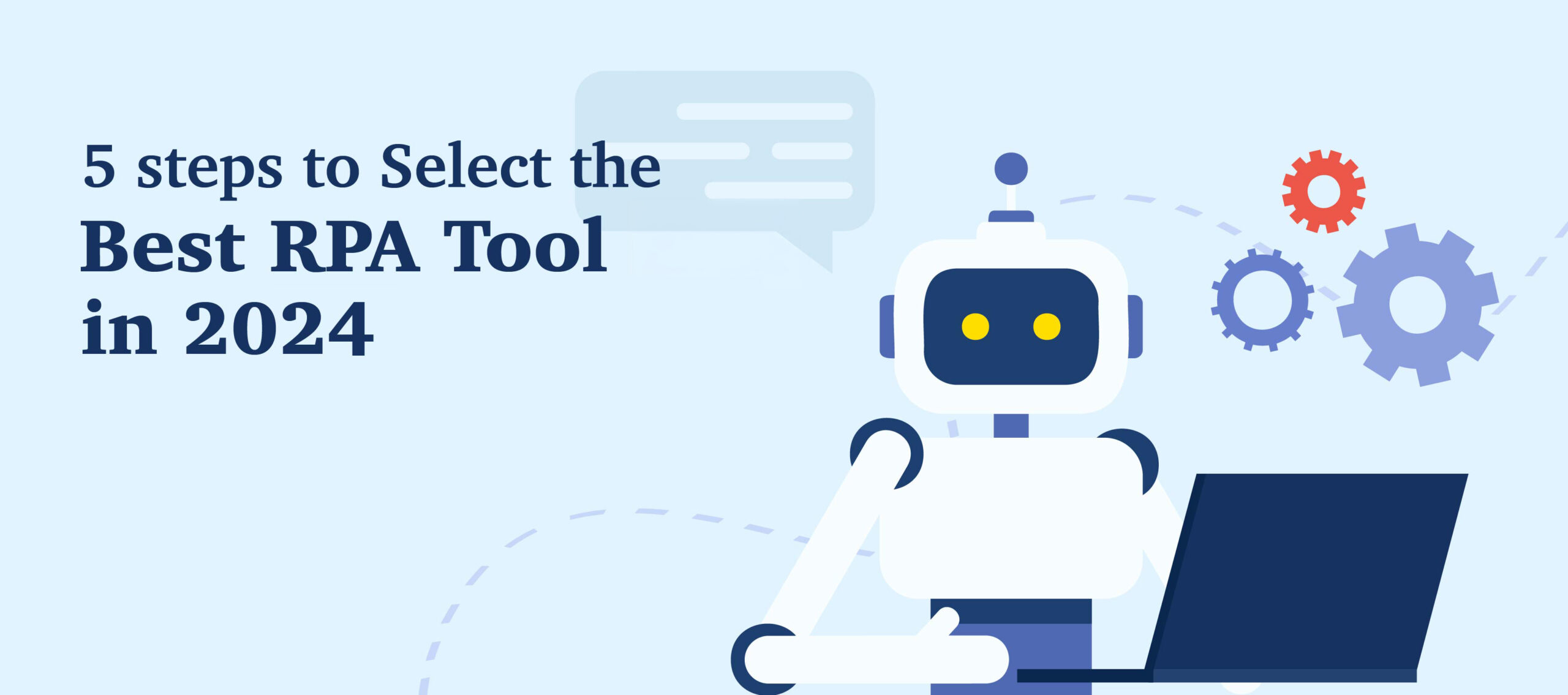
5 Steps to Select the Best RPA Tool in 2024
RPA can be used in some firms to update outdated software without replacing it. Business apps in most firms function flawlessly yet often force users to click on the same boxes in the same ways all day. By adding a new layer to automate repeated processes without requiring a complete redesign of the program, RPA technologies seek to replace that tedious work. The capacity to quickly adjust to changes is a vital competitive advantage in the fast-changing market of 2024.
Robotic Process Automation tool helps small to medium-sized businesses (SMBs) stay ahead of the curve by allowing them to swiftly modify their procedures in response to evolving market conditions, governmental regulations, or client needs. With RPA, your company can automate repetitive operations and complete them quickly and robotically.
5 Steps to Select the Best RPA Tool in 2024
The following are the 5 steps to select the best RPA tool in 2024:
-
Define your Requirements and Objectives
You must have well-defined goals before searching for the best RPA software solution. Making the right decision will be aided by having a clear understanding of your tasks’ state (including how repetitive, rule-based, and non-intelligent they are, among other factors) and a clear understanding of your needs and objectives. A typical RPA solution could be the best option for your company if its automation demands are somewhat simple.
The same holds for scaling up easy procedures.
Also Read: The Role of RPA in Risk Management and Governance
-
Evaluate RPA Tools and Features
It’s essential to match the goals and needs of your business when choosing an RPA technology. There should be less downtime and a smooth transition by connecting the tool smoothly with current systems. The most important aspect of RPA automation software that influences an enterprise’s decision to select a solution is its technical features. Scalability, perceptibility, and screen slicing are a few features to consider. Before implementing RPA, enterprises should also take into account its security aspects.
RPA needs access to the firm’s confidential data for information aggregation. The business is not allowed to reveal any of the private information. Thus, enterprises risk having their data stolen if they don’t trust the security of RPA.
- Consider Vendor Reputation and Support
It helps you determine how much of your business processes can be automated before you can begin selecting a provider. Do you only have a few procedures automated right now, or do you have plans to automate more in the future? Is a custom solution required, or will a conventional solution be adequate? Simplifying your firm’s automation requirements using a standard RPA technology can be the best action. The same holds for scaling up easy procedures.
Also Read: How Robotic Process Automation is Transforming Warehouse Management
An enterprise needs a partner with a comprehensive automation approach as part of a more extensive content services strategy, not just a tool, to solve the difficulties of vast and complicated operations.
- Assess Total Cost of Ownership (TCO)
An estimate of the costs involved in buying, deploying, utilizing, and retiring a product or piece of equipment is called the total cost of ownership, or TCO. The actual cost, or TCO, measures the purchase price throughout the product’s lifecycle. To guarantee that they choose the best tool to suit their automation objectives and to gain a comprehensive understanding of how RPA adoption will affect profitability over time, businesses must calculate the TCO of an RPA solution.
Also Read: Why Robotic Process Automation is Ideal for Today’s Remote Workforce
- Pilot and Proof of Concept (POC) Testing
The Proof of Concept (POC) will use a small-scale RPA solution that automates a few chosen business operations to show the potential advantages of RPA. Many providers of a Robotic Process Automation tool will offer a Proof of Concept (PoC) automation (bot) to carry out a simple task to demonstrate the practicality of RPA in the customer’s setting. However, these bots are usually not production-ready, and more work will be needed to ensure that all business and system rules are considered.
Conclusion
As Artificial Intelligence shapes a Robotic Process Automation tool into more dependable digital workers and IT teams provide them with stronger data foundations, bots will become more powerful than they were previously. RPA effectively manages many repetitive activities, such as those found in administration. However, businesses will benefit far more from RPA if combined with AI and made more accessible to citizen developers. This is what we’re seeing in the following automation trends.
The RPA market will continue to consolidate and grow more competitive, but growth will also decelerate.
Recent Blogs
- RPA Software Solution: Transforming Business with Smarter Automation Tools
- Salesforce Implementation Services: Meet Your New AI Teammates
- Salesforce Services: How Modern Engineering Is Revolutionizing CRM Solutions
- Salesforce Implementation Services: AI-First Integration with Agentforce for Smarter API Documentation & Governance
- 5 Benefits for App Success: Hire Remote React Native Developers
Categories
- Agritech (1)
- AR/VR (5)
- Artificial Intelligence (55)
- Machine Learning (1)
- Blockchain (4)
- Business Intelligence (3)
- CRM (5)
- SalesForce (4)
- Data Engineering (8)
- Data protection (2)
- Development (102)
- Golang Development (15)
- Python Web Development (9)
- React JS (5)
- React native (10)
- Devops (3)
- Hire Developers (3)
- Internet of Things (IoT) (5)
- Kubernetes (2)
- Machine Learning (2)
- Mobile App Development (44)
- Node.js (7)
- outsourcing (7)
- Partnership (4)
- Performance Testing (3)
- RPA (21)
- Security (24)
- Strategy (1)
- Testing (110)
- Accessibility Testing (2)
- Automation Testing (22)
- Dynamic Testing (1)
- Manual Testing (3)
- Mobile App Testing (13)
- Offshore Software Testing (6)
- Penetration Testing Services (13)
- QA testing (16)
- Remote Software Testing (7)
- Software Testing (19)
- Website Design (22)